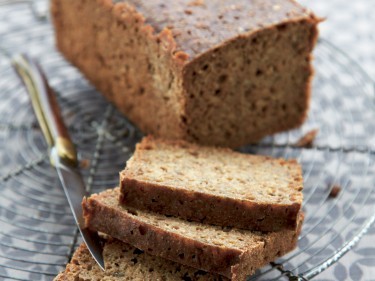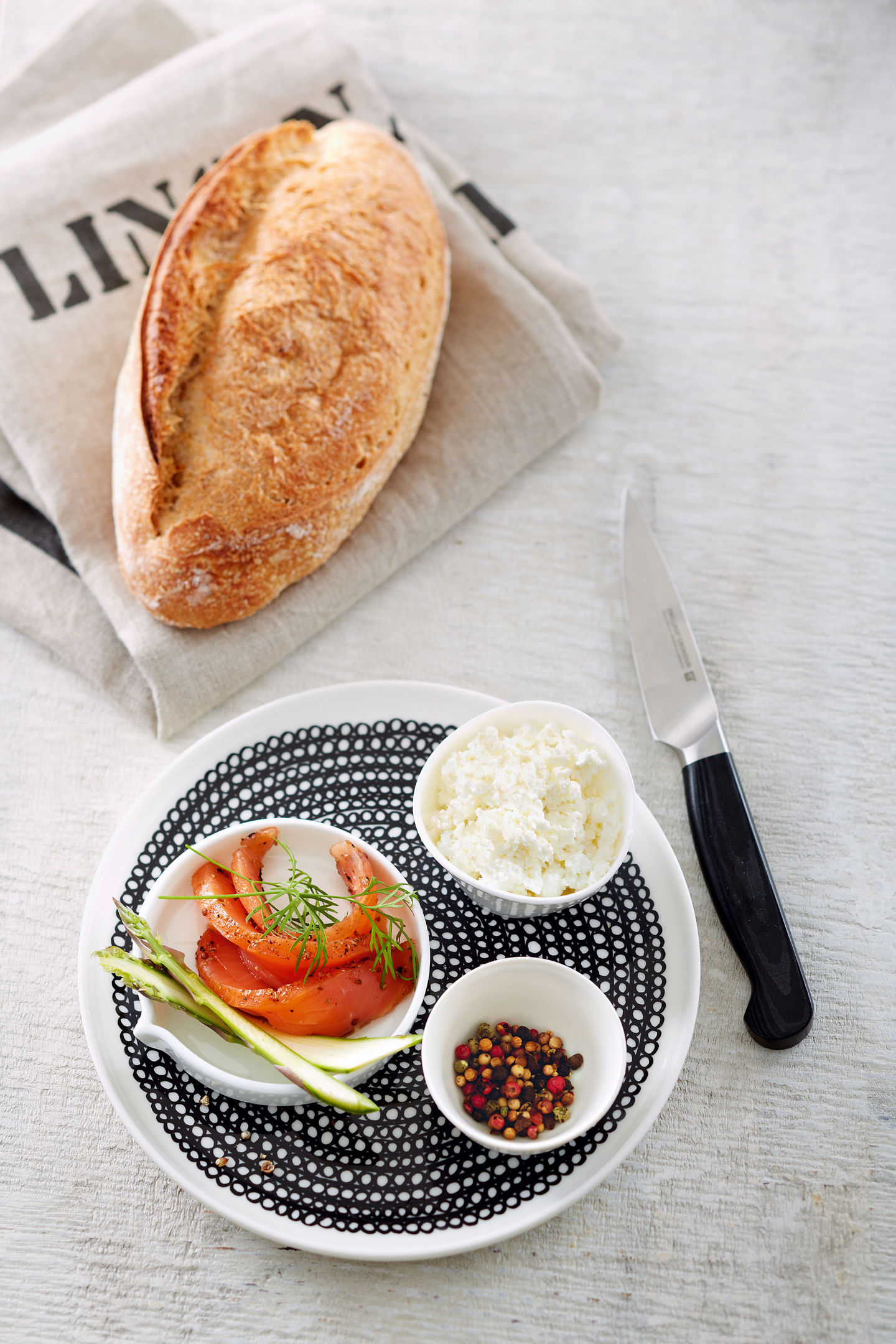Baking bread from scratch is daunting, but have patience and the results will be worth it, says Eric Kayser. Jeananne Craig rolls her sleeves up to meet the French master baker
Watching French baker Eric Kayser at work in the kitchen, it’s easy to see why he didn’t consider any other career options in his youth.
The bread guru deftly cuts dough into small sections before rolling them into perfect little batards (like a baguette, but shorter), then presses an already-baked one to listen for that familiar crispy sound, explaining: “You want to hear the music.”
A fifth-generation baker growing up in the Franche-Comte region, Kayser loved spending time in his father’s bakery.
“As soon as I started to speak, I said to my family, ‘I want to be a baker and travel’,” the red-headed boulanger recalls.
“Coming from a small village, people thought I was crazy, but I repeated it when I was 10 years old, I repeated it I was 14 years old. And now, I do it.”
Kayser opened his first bread shop in Paris in 1996, and these days, he jets around the world to open new bakeries and “bring a love of French bread to people who have never tasted it”.
He’s in the UK to promote his new book, The Larousse Book Of Bread (containing more than 80 mouth-watering recipes), and pass on some of his expert tips on creating the perfect brioche, baguette or bagel.
Making bread isn’t easy, but with simple equipment and good ingredients (“the most important thing”), something delicious can be created, according to Kayser.
“If you have a small mixer, a good oven and your hands, it will be OK. And a good brain!”
With all that kneading and proofing, however, baking bread from scratch isn’t something most people can factor into their busy lives. But giving it a go once a week – or even once a month – is fine, says Kayser.
“You can do your bread or your brioche with your children, with your husband or wife, with your family, and afterwards you can share it,” the father-of-two adds.
“I think it’s something very religious, because we hear for a long time that we need to share the bread. It’s fantastic, it’s a good experience and it’s good for you to work with your hands.”
And if the end result is an underdone or burnt-to-a-crisp disaster? “Patience is very important, and you can start again. All your life you need to be patient. If you want to do something, you need to do it a few times and understand how it will be,” he says.
As the smell of freshly-baked bread fills the air, Kayser explains that he views the baker as an alchemist.
“You work with a few ingredients from the ground – flour, water, yeast – to do something beautiful.”
And biting into the delicious end result, it’s hard to disagree.
Want to have a try at home? Here are three of Kayser’s recipes. The liquid sourdough starter is used as an ingredient in the batard and pumpernickel recipes, although dry sourdough starter can also be used.
LIQUID SOURDOUGH STARTER
(Makes about 500g/4 cups)
140g (scant 1 1/2 cup) organic light, medium, or dark rye flour
240g (1 cup) water at 86F (30C) temperature
10g clear honey (or malt)
100g (generous 3/4 cup) all-purpose (plain) flour
DAY 1
Use a spatula to mix 20g (1/4 cup) rye flour with 20g (4 teaspoons) water in a bowl, then add 5g (3/4 teaspoon) clear honey. Cover with a clean cloth and leave for 24 hours in a warm place. If the starter curdles, begin again.
DAY 2
Bubbles will have formed on the surface. In a larger container, mix together 40g (scant 1/2 cup) rye flour, 40g (2 2/3 tablespoons) water, and 5g (3/4 teaspoon) clear honey. Stir in the mix from the first day. This is called “feeding” or “refreshing” the starter. Cover with a cloth and leave to ferment for 24 hours.
DAY 3
The mixture will be bubbling noticeably. Mix 80g (3/4 cup) rye flour and 80g (generous 2/3 cup) water in a larger bowl. Blend in the mix from the second day. Cover with a cloth and leave to ferment for 24 hours.
DAY 4
To the third day’s mix, add the all-purpose (plain) flour and 100g (scant 1/2 cup) water. Stir well. Your starter is now ready to use. It will have the consistency of thick pancake batter. Store it in a glass jar, lightly covered, but so that air can get to the starter. (If you plan to keep it for some time, it should be stored airtight in the refrigerator.)
BATARD
(Makes 3 batards, each about 300g)
Timings:
Mixing & kneading: 10min
First rising: 1h 30min
Resting: 30min
Proofing: 1h 30min
Baking: 20min
500g (4 cups) all-purpose (plain) flour, plus extra for dusting
330g (1 1/3 cups) water at 68F (20C)
100g (scant 1/2 cup) liquid sourdough starter (or 25g/3tbsp dry sourdough starter, try Bread Matters Original Sourdough Starter, www.buywholefoodsonline.co.uk)
3g (1tsp) fresh baker’s yeast, crumbled
10g (2tsp) salt
If kneading in a stand mixer: Put all the ingredients in the bowl. Knead with the dough hook for four minutes at slow speed, then for six minutes at high speed.
If kneading by hand: Put the flour on a work surface or in a mixing bowl and make a large well in the centre. Add half the water, then add the starter, fresh yeast, and salt. Mix well, then add the remaining water and blend until all the flour is incorporated. Knead the dough until it becomes smooth and elastic.
Shape the dough into a ball and cover with a damp cloth. Leave to rise for 1 hour 30 minutes. It will have increased in volume by the end of the rising time.
Dust the work surface. Divide the dough into three equal pieces and shape them into balls. Cover with a damp cloth and leave to rest for 30 minutes.
Working with one piece of dough at a time, use the palm of your hand to flatten it gently into a rough oval. With the long side facing you, fold in a third towards the centre and press along the edge with your fingertips. Swivel the dough 180 degrees. Fold in the other long edge so that it overlaps in the centre and press with your fingertips. Fold one half on top of the other, and seal the edges together with the heel of your hand. With lightly floured hands, roll the dough out to form a plump oval, slightly tapered at each end. Shape the other two loaves the same way.
Place the loaves, seams underneath, on a baking sheet lined with parchment (baking) paper. Cover with a damp cloth and leave to proof for 1 hour 30 minutes.
Place another baking sheet on the bottom shelf of the oven and preheat to 450F (230C). Score each loaf once, lengthwise. Just before putting the loaves in the oven, pour an extra 50g (scant 1/4 cup) of water onto the preheated baking sheet. Bake for 20 minutes.
Remove from the oven and leave to cool on a wire rack.

PUMPERNICKEL
(Makes two loaves, each about 615g)
Timings:
Mixing & kneading: 8min
First rising: 1hr
Proofing: 16-20hrs
Baking: 6hrs
300g (2 cups) dark rye flour
150g (1 1/4 cups) all-purpose (plain) flour
50g (generous 1/4 cup) pre-cooked bulgur wheat
500g (generous 2 cups) water at 80F (25C)
120g liquid sourdough starter (or 25g/2tbsp dry sourdough starter)
10g (2tsp) salt
60g (1/4 cup) clear honey
40g (1/4 cup) mixed seeds (anise, coriander, fennel, and caraway)
Butter for greasing
You will need two loaf pans with sliding lids, each 6 1/2 x 3 x 3 inches (17 x 7.5 x 7.5 cm). Alternatively, use ordinary loaf pans, although you won’t get the same oblong shape.
If kneading in a stand mixer: Put the two flours, bulgur wheat, water, starter, salt and honey in the bowl. Knead with the dough hook for four minutes at low speed, then for four minutes at high speed. Add the mixed seeds towards the end of the kneading time, and knead until the mixture is creamy.
If kneading by hand: Put the two flours and the bulgur wheat in a mixing bowl and make a large well in the centre. Pour in half the water, starter, salt and honey. Mix well, then add the remaining water and knead until all the flour is incorporated. Add the mixed seeds and knead until the mixture is creamy.
Cover the bowl with a damp cloth and leave the dough to rest for one hour. It will have increased in volume by the end of the rising time.
Butter the loaf pans and their lids. Fill them two-thirds full with the dough and smooth the surface. Close the lids and leave to proof for 16-20 hours, by which time the dough will have expanded to almost fill the pans.
Preheat the oven to 230F (110C). Make sure the lids are on securely and bake for six hours.
Remove from the oven, turn out the loaves, and leave to cool on a wire rack.
The Larousse Book Of Bread: Recipes To Make At Home, by Eric Kayser, is published by Phaidon, priced £24.95. Available now.

